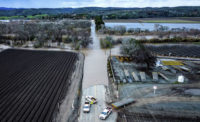Earlier this month the Obama Administration breathed new life into the FutureGen experimental “clean coal” electric generating plant in Mattoon, Ill., that would trap and store carbon dioxide emissions. The administration pledged $1 billion to its development.
Initially introduced by the Bush administration in 2003 as a means to develop low-emissions coal-fired power plants, the project was dropped early last year due to cost overruns. FutureGen Alliance, a consortium of coal and utility companies working to build the plan, estimate the project will cost approximately $2.4 billion to complete.
A decision on whether to go forward with construction on the plant – which will combine coal gasification technology and underground storage of CO2 – is expected to be made early next year.
This week, ENR spoke with Sarah Forbes , a senior associate at the World Resources Institute a non-profit environmental think tank based in Washington, D.C. about the importance of the FutureGen project for the development of Carbon Capture and Storage (CCS).
She developed her expertise on CCS during and 8-year stint with the U.S. Dept. of Energy’s National Energy Technology Laboratory (NETL) doing program management and energy analysis.

What is the significance of the FutureGen project for the development of clean coal energy generation?
It’s a really important step for the development of the technology. It’s at a larger scale than most of the previous projects and it is integrating power production with CCS is through the gasification aspect using a hydrogen turbine. The thing that is important to remember is that there are multiple approaches to carbon capture and there are multiple types of geological formations we need to store the CO2 in. It’s fantastic we are moving forward and this will help pave the way for more projects that can utilize different geologies.
Has the storage of the CO2 been arranged?
They have done some testing and actually the state of Illinois funded studies to better understand the geology. The findings indicate the geology of the site is good for CCS but part of the research aspect of this project is collecting the information and proving that.
Will FutureGen provide solutions for similar efforts to dispose of carbon underground?
One of the challenges for CCS from the geological perspective is that the geological world is really diverse. It’s very important that when we chose a site for a project that we use site specific geological information and build a model based on that. There are some things we will find out for the FuteureGen project that will prove true for that geological basin but that won’t replace the need to do site-specific geological assessments to characterize another individual site if we can do it at another location.
What about in terms of the energy generation method?
It’s a learning platform. Gasification is very different [from what] we’ve done up to now. There has been some demonstration scale work on gasification but most of our information has been derived from power projects using pulverized coal plants. This will teach us specifically about the requirements needed for gasification and specifically gasification with carbon capture.
What will be done to accommodate for the additional energy needed to utilize these technologies?
A: There is certainly an energy penalty associated with CCS. While there will be an energy penalty the scale of the plant that was originally proposed was 275 MW and I do think this is our most efficient scale to begin to understand the nuances of integrated CCS. There’s always going to be uncertainties particularly on the technology side but not so much on the scale side.
What advances in these types of clean coal efforts are being made elsewhere?
It very interesting that when you look at the funding announcements for CCS worldwide, the Australians are looking at projects on a much bigger scale. They are looking at projects in the 1,000MW range while, for the most part, the Europeans stay under 300MW. From the perspective of policy, they have certainly been marching ahead of the rest of the world.
How far away for full-scale commercial use?
It’s a good question but not one we have a clear answer for. We have to see the demonstrations of the different approaches and technical formations before being able to confidently project that. I’m worried that we are counting on the technology when we haven’t yet tried this on that scale. A lot of people ask “are we ready to deploy the technology?” and we aren’t at a point to answer that. It is coming along much faster than even just a year ago and worldwide number of demonstrations is really significant but – they are demonstrations.



Post a comment to this article
Report Abusive Comment